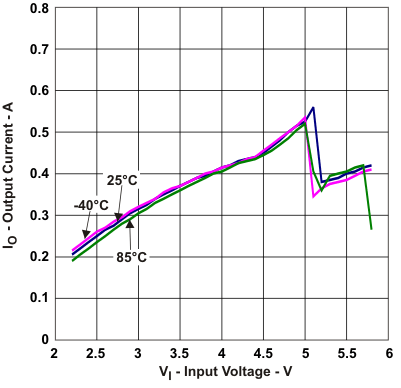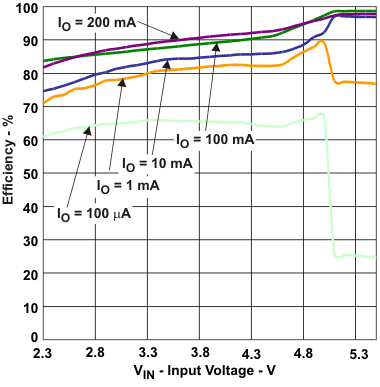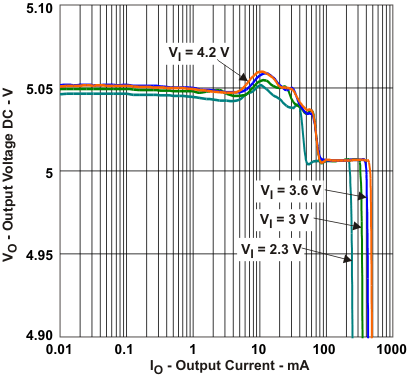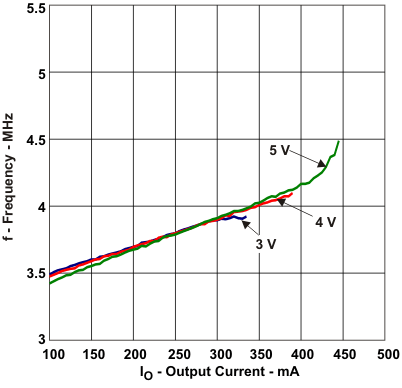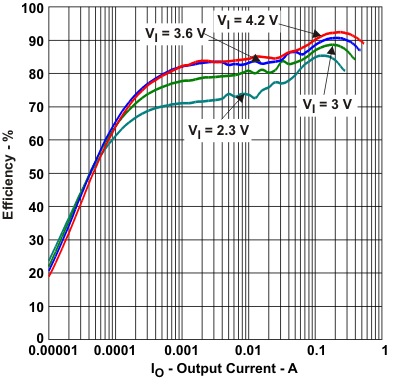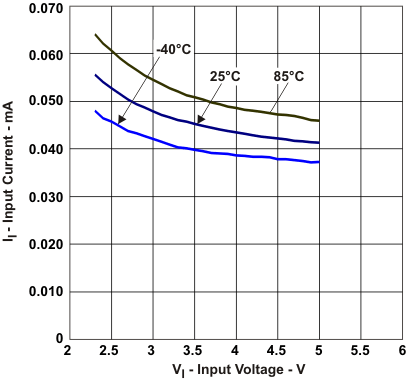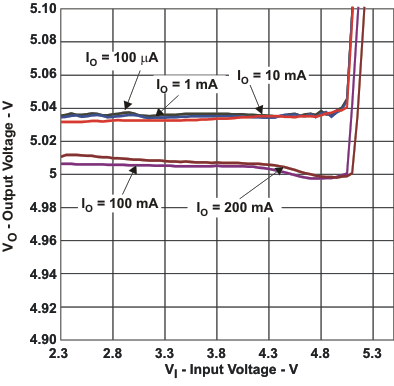SLVS806D April 2009 – December 2015 TPS61240 , TPS61241
PRODUCTION DATA.
- 1 Features
- 2 Applications
- 3 Description
- 4 Revision History
- 5 Device Options
- 6 Pin Configuration and Functions
- 7 Specifications
- 8 Parameter Measurement Information
- 9 Detailed Description
- 10Application and Implementation
- 11Power Supply Recommendations
- 12Layout
- 13Device and Documentation Support
- 14Mechanical, Packaging, and Orderable Information
Package Options
Mechanical Data (Package|Pins)
Thermal pad, mechanical data (Package|Pins)
- DRV|6
Orderable Information
7 Specifications
7.1 Absolute Maximum Ratings
over operating free-air temperature range (unless otherwise noted)(1) (2)| MIN | MAX | UNIT | ||
|---|---|---|---|---|
| VI | Input voltage on VIN, L, EN | –0.3 | 7 | V |
| Voltage on VOUT | –2.0 | 7 | V | |
| Voltage on FB | –2.0 | 14 | V | |
| Peak output current | Internally limited | A | ||
| TJ | Maximum operating junction temperature | –40 | 125 | °C |
| Tstg | Storage temperature | –65 | 150 | °C |
(1) Stresses beyond those listed under Absolute Maximum Ratings may cause permanent damage to the device. These are stress ratings only and functional operation of the device at these or any other conditions beyond those indicated under Recommended Operating Conditions is not implied. Exposure to absolute–maximum–rated conditions for extended periods may affect device reliability.
(2) The human body model is a 100 pF capacitor discharged through a 1.5 kΩ resistor into each pin. The machine model is a 200 pF capacitor discharged directly into each pin.
7.2 ESD Ratings
| VALUE | UNIT | |||
|---|---|---|---|---|
| V(ESD) | Electrostatic discharge(2) | Human-body model (HBM), per ANSI/ESDA/JEDEC JS-001(1) | ±4000 | V |
| Charged-device model (CDM), per JEDEC specification JESD22-C101(2) | ±500 | |||
| Machine model (MM) | ±200 | |||
(1) JEDEC document JEP155 states that 500-V HBM allows safe manufacturing with a standard ESD control process. Manufacturing with less than 500-V HBM is possible with the necessary precautions.
(2) JEDEC document JEP157 states that 250-V CDM allows safe manufacturing with a standard ESD control process. Manufacturing with less than 250-V CDM is possible with the necessary precautions.
7.3 Recommended Operating Conditions
| MIN | NOM | MAX | UNIT | |||
|---|---|---|---|---|---|---|
| VIN | Input voltage range | 2.3 | 5.5 | V | ||
| L | Inductance | 0.4 | 1 | 1.5 | µH | |
| CO | Output capacitance | TPS61240 TPS61241 |
1 | 20 | µF | |
| TPS61242 | 0.8 | 10 | µF | |||
| TA | Operating ambient temperature | –40 | 85 | °C | ||
| TJ | Operating junction temperature | –40 | 125 | |||
7.4 Thermal Information
| THERMAL METRIC(1) | TPS6124x | UNIT | ||
|---|---|---|---|---|
| YFF | DRV | |||
| 6 PINS | 6 PINS | |||
| RθJA | Junction-to-ambient thermal resistance | 132.7 | 104.1 | °C/W |
| RθJC(top) | Junction-to-case (top) thermal resistance | 1.2 | 97.1 | |
| RθJB | Junction-to-board thermal resistance | 22.4 | 74.0 | |
| ψJT | Junction-to-top characterization parameter | 5.2 | 4.5 | |
| ψJB | Junction-to-board characterization parameter | 22.4 | 74.4 | |
| RθJC(bot) | Junction-to-case (bottom) thermal resistance | — | 48.4 | |
(1) For more information about traditional and new thermal metrics, see the IC Package Thermal Metrics application report, SPRA953.
7.5 Electrical Characteristics
Over full operating ambient temperature range, typical values are at TA = 25°C. Unless otherwise noted, specifications apply for condition VIN = EN = 3.6V. External components CIN = 2.2μF, COUT = 4.7μF 0603, L = 1μH, refer to Parameter Measurement Information section.| PARAMETER | TEST CONDITIONS | MIN | TYP | MAX | UNIT | |
|---|---|---|---|---|---|---|
| DC-DC STAGE | ||||||
| VIN | Input voltage range | 2.3 | 5.5 | V | ||
| VOUT | Fixed output voltage range | 2.3 V ≤ VIN ≤ 5.5 V, 0 mA ≤ IOUT ≤ 200 mA | 4.9 | 5.0 | 5.1 | V |
| VO_Ripple | Ripple voltage, PWM mode | ILOAD = 150 mA | 20 | mVpp | ||
| ISW | Output current | VIN 2.3 V to 5.5 V | 200 | mA | ||
| Switch valley current limit | VOUT = VGS = 5.0 V (TPS61240) | 500 | 600 | mA | ||
| VOUT = VGS = 5.0 V (TPS61241, TPS61242) | 600 | 700 | ||||
| Short circuit current | VOUT = VGS = 5.0 V | 200 | 350 | mApk | ||
| High side MOSFET on-resistance(1) | VIN = VGS = 5.0 V, TA = 25°C(1) | 290 | mΩ | |||
| Low Side MOSFET on-resistance(1) | VIN = VGS = 5.0 V, TA = 25°C (1) | 250 | mΩ | |||
| Operating quiescent current | IOUT = 0 mA, Power save mode | 30 | 40 | μA | ||
| Shutdown current | EN = GND | 1.5 | μA | |||
| Reverse leakage current VOUT | EN = 0, VOUT = 5 V | 2.5 | μA | |||
| Leakage current from battery to VOUT | EN = GND | 2.5 | μA | |||
| Line transient response | VIN 600 mVp-p AC square wave, 200 Hz, 12.5% DC at 50/200 mA load |
±25 | ±50 | mVpk | ||
| Load transient response | 0–50 mA, 50–0 mA VIN = 3.6V TRise = TFall = 0.1 μs | 50 | mVpk | |||
| 50–200 mA, 200–50 mA, VIN = 3.6 V, TRise = TFall = 0.1 μs | 150 | |||||
| IIN | Input bias current, EN | EN = GND or VIN | 0.01 | 1.0 | μA | |
| VUVLO | Undervoltage lockout threshold | Falling | 2.0 | 2.1 | V | |
| Rising | 2.1 | 2.2 | V | |||
| CONTROL STAGE | ||||||
| VIH | High level input voltage threshold, EN | 2.3 V ≤ VIN ≤ 5.5 V | 1.0 | V | ||
| VIL | Low level input voltage threshold, EN | 2.3 V ≤ VIN ≤ 5.5 V | 0.4 | V | ||
| OVC | Input overvoltage threshold | Falling | 5.9 | V | ||
| Rising | 6.0 | |||||
| tStart | Start-up time | Time from active EN to start switching, no-load until VOUT is stable 5 V | 300 | μs | ||
| DC-DC STAGE | ||||||
| ƒ | See Figure 7 (Frequency Dependancy vs IOUT) | 3.5 | MHz | |||
| TSD | Thermal shutdown | Increasing junction temperature | 140 | °C | ||
| Thermal shutdown hysteresis | Decreasing junction temperature | 20 | °C | |||
(1) DRV package has an increased RDSon of about 40mΩ due to bond wire resistance.
7.6 Typical Characteristics
7.6.1 Table of Graphs
| Figure | ||
|---|---|---|
| Maximum Output Current | vs Input Voltage | Figure 1 |
| Efficiency | vs Output Current, Vout = 5V, Vin = [2.3 V; 3.0 V; 3.6 V; 4.2 V] | Figure 2 |
| vs Input Voltage, Vout = 5 V, Iout = [100 µA; 1 mA; 10 mA; 100 mA; 200 mA] | Figure 3 | |
| Input Current | at No Output Load, Device Disabled | Figure 4 |
| Output Voltage | vs Output Current, Vout = 5 V, Vin = [2.3 V; 3.0 V; 3.6 V; 4.2 V] | Figure 5 |
| vs Input Voltage | Figure 6 | |
| Frequency | vs Output Load, Vout = 5 V, Vin = [3.0 V; 4.0 V; 5.0 V] | Figure 7 |
